Community
EMS Spotlight
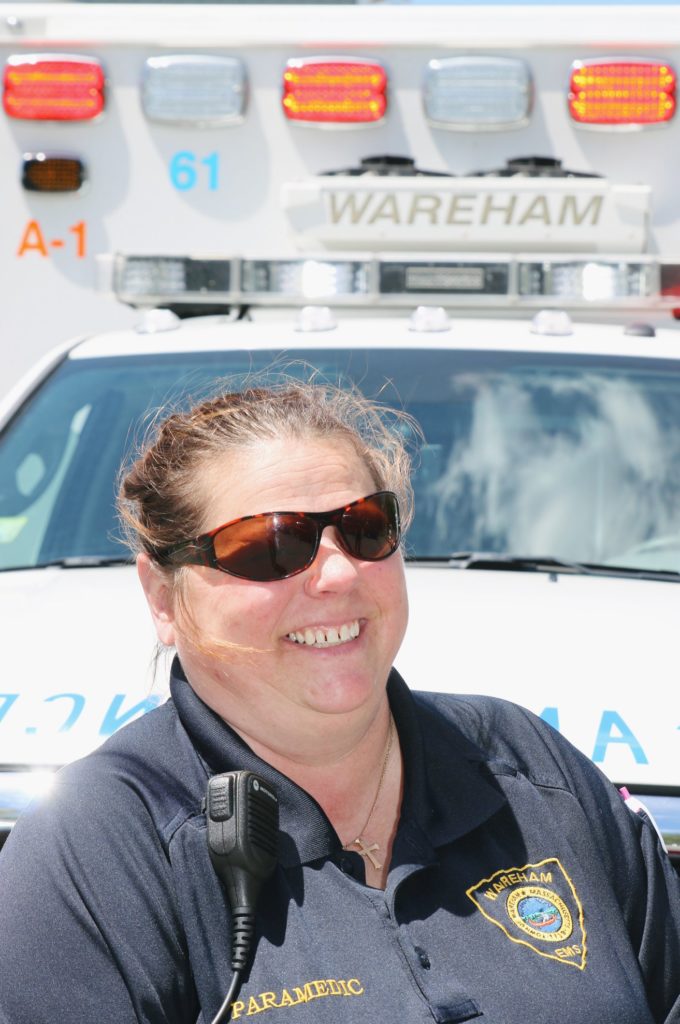
This is Mama G. She’s officially retired, but still somehow ends up working 40 to 50 hours a week for the Wareham Emergency Medical Services Department, in addition to Marion EMS, and as an Emergency Department Nurse at Southcoast Health’s Tobey Hospital.
Cat Giannelli has served at Wareham EMS for 34 years – a tenure that ranks second only to Director David Evans’s – and her “less senior” colleagues look up to her for guidance, advocacy, and support … hence her nickname around the station.
“I’m born and bred here,” Giannelli says. “This is my town. I’m very fortunate to work in my town. I went to school here, I’m very involved at St. Patrick’s Church, and when my kids were growing up here, I coached their soccer teams, softball teams, and basketball teams. I’ve been teaching CPR for 30 years.”
Giannelli set out to become a veterinarian, but married at 19 and left college. In 2007, two decades after becoming an EMT, she would earn her Bachelor of Science in chemistry, followed quickly by her nursing license and continuing education.
“I wanted to show my children, ‘Don’t ever give up,'” Giannelli says. Her four kids clearly got the message – two were high school valedictorians, and two are in Master’s programs.
“Being a parent, it’s just about being involved. My husband and I were always involved. We never forced them to do anything, but we always made sure they followed through.”
They have come to learn, like Giannelli has, that a dedication to achievement is its own reward.
“I worked hard for my license. I work hard to keep my license up year after year, getting re-certified. We all do. Sure, most of the stuff is routine stuff. ‘Oh, you got a cold, you got a cough, you got this, you got that.’ But those critical calls, we want you to know that we’re ready, so if you call us at 8 in the morning, 8 at night, 3 in the morning, 3 in the afternoon, we know what we have to do. It’s my responsibility. It’s my passion. I don’t have to just take care of myself – I’m strong enough to take care of everybody. I got into this field not to make money, but to help people.”
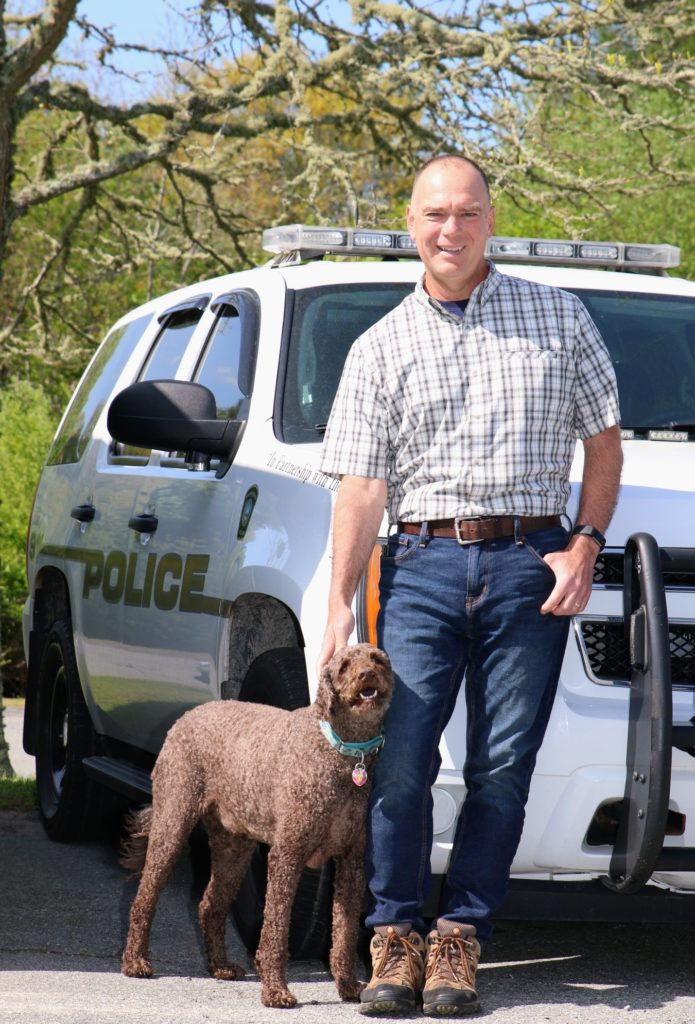
Saving lives for a living is in Anthony Days’s blood.
His grandfather was a medic in World War I, and, from a young age, Days has always felt a pull toward public safety. He realized his dream of becoming a first responder in 1986 as a firefighter and EMT, and would soon “jump onboard” the Mattapoisett Police Department — which itself is an anomaly in that it also runs the town’s EMS.
“I fell in love with it. One of the greatest feelings from the very beginning has been being able to take care of people you’ve known your whole life, and that kept me rooted in Mattapoisett, where I was born and raised,” says Days, who has been instrumental in equipping area agencies with defibrillators.
“I’ve really enjoyed being able to infuse EMS into law enforcement. The public sometimes has a certain stereotype of a law enforcement officer; they’re not always prepared to see a police officer start an IV, you know what I mean? In our department, it’s normal for the first one on scene to be a police officer and crawl into a wreck and start rendering aid beyond basic life support. That has always been a fulfilling aspect of the job, especially when it comes to our most vulnerable populations. I’ve been fortunate to serve as a captain in this town, which has supported us so well.”
Days retired on May 4. But he and his loyal Labradoodle, Teddy, can still be spotted all over the Tri-Town and beyond, teaching CPR, wilderness survival, and … art?
“I had this great opportunity to go into our Center School and teach the children art, because I paint,” Days says. “So, I would go in as a ‘visiting artist’ for Ms. Perry, the art teacher, sometimes with a smock over my uniform, and give the kids the lesson and then take my smock off, and their jaws would drop when they saw a policeman. It was fun.”
(See his impressive and powerful paintings, many of which draw on his career and community, at A. Days WORK. He’s currently opening a gallery at Hatch Street Studios.)
“I’ve just decided I’m going to start painting more and doing things like that. I’m still teaching CPR, because it’s my passion. I still feel like that makes such a difference out in the real world now, especially with overdoses, because you can actually save a life just by breathing for them,” Days says. “Narcotic overdoses knock the respiratory drive down, but if they’re young enough and have a healthy heart, you can keep them alive until help arrives.”
Days credits Southcoast Health with sponsoring his education as a paramedic and for the interceptor rescue truck that “intrigued” him as a young EMT:
“I’ve always been grateful for the opportunities I’ve had through Southcoast, because I would have never gotten here without them,” he says.
“They’ve provided communities like mine with all of the help we’ve needed for Advanced Life Support services. For me, and for us, it’s all about educating the public and the next generation of first responders.”
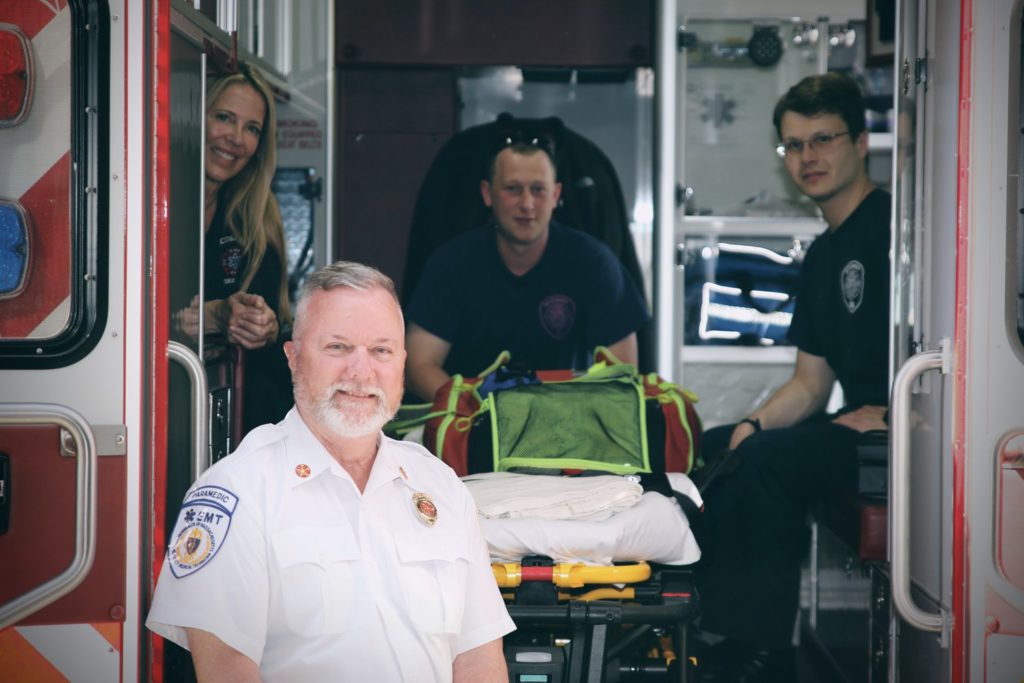
An ice pack, or fentanyl.
Until recently, those were your only two options if you were in pain and picked up by an ambulance. More to the point, those were the only two options available to EMS personnel.
“It struck us as odd that, at the height of an opioid crisis, the only medication we had to manage someone’s pain on the way to the hospital was an opioid. And of all the opioids you’re going to use, fentanyl is not what you want to be giving Mr. Smith or Granny or Young Bob for many of their injuries,” Acushnet Fire Chief and EMS Director Kevin Gallagher says.
“So, in 2017, we asked Dr. Matt Bivens, St. Luke’s EMS Medical Director, ‘What types of alternatives are there? Is anyone thinking of an alternative?’ At the time, through our conversations, we discovered there was an assumption that there were non-opioid pain medications available, but they were too expensive. So, we researched it, and it turned out that the United Kingdom was a few years ahead of us, and there was one particular drug, Ofirmev, which is an IV acetaminophen, that had been approved. We reached out to the company, and the cost was no more expensive than other life-saving medications that we use — $38 per dose, and reimbursable by the insurance companies.”
Dr. Bivens delivered the research to the Massachusetts Office of Emergency Services and recommended supplying area ambulances with Ofirmev. The change was approved seven minutes later.
“But the bureaucratic process ended up taking much longer,” Gallagher says today.
“It hit a logjam. Codes and regulations move at a glacial speed, and they’re designed to, because you want to get it right. But one month turned into three, and three turned into six. We knew the state was hungry for a change. And this was a no-brainer. We weren’t asking to take fentanyl off, but just give us this extra tool! Paramedics are a smart group of people. Give them the tools, step back, and watch them work. Finally, after many people’s efforts, Gov. Baker received word and intervened. And things moved really fast after that. We got the approval, we got the training, and, in 2018, there was a 52% reduction in the amount of fentanyl we used. In 2019 so far, we’ve only used fentanyl twice, because we have the IV acetaminophen.”
In addition to the decline in administering fentanyl, the town has seen a decrease in overdoses during the same time period.
“We have no documentation showing a direct link between the use of fentanyl on our rescues and cases of addiction and future overdose, but don’t tell me it hasn’t happened, whether here or across the country,” Gallagher says. “In 2017, we had 20 overdoses; 2018, 17; and during the first half of 2019, two. I don’t think we can point to any one thing, but here in Acushnet, with the backing of the Board of Selectmen, and through the work of staff, we’ve taken a five-point approach to this, because the federal government is not going to fly in on a dragon and win this for us. All crises start and end locally.”
Here’s the “Acushnet Model” implemented by Gallagher:
“First, a public awareness campaign: Starting a few years ago, we planted a purple flag on Main Street for every overdose to keep the community attuned to the issue. In 2016, I bought 40 flags, and planted 36.”
“Number two, we started a program with the Greater New Bedford Interfaith Council to send the attending paramedic and a member of the clergy to the patient’s house a couple of days after their overdose, if circumstances allow and with police approval, because that’s within the window where they’ll consider treatment services. No heavy-handed religious stuff — just informational.”
“Next, dirty needles. We purchased a machine that sterilizes them and grinds them down to a point where they can go out in the regular garbage”
“Fourth, the IV acetaminophen.”
“And the fifth, our drug deactivation pouches. They can hold up to a dozen or so pills, and you drop them in, add water, shake it, and charcoal is activated from the pouch, binding to the medication and making it inert, and you can throw it in the garbage. We got 20,000 of them. With the help of a major community effort, they’re in churches, schools, and civic groups. We got another 20,000 and gave them to Southcoast Health. Visiting nurses have been using them, and the Emergency Department is considering including them with every prescription written for a narcotic.”
Gallagher says he has worked “hand in hand” with Bivens, St. Luke’s Chair of Emergency Medicine Dr. Jennifer Pope, EMS Affiliate Medical Director Liaison Brian Giorgianni, and others at Southcoast to reverse some devastating trends.
“This is personal to me,” says Gallagher, a firefighter for 34 years, and a chief for 16. “Like many people, I have lost a loved one to opioids. My nephew. For my family, for our neighbors and residents, and for everyone else, we will try anything. After 2015, 2016, and 2017, we just had to do something. And it’s working.”
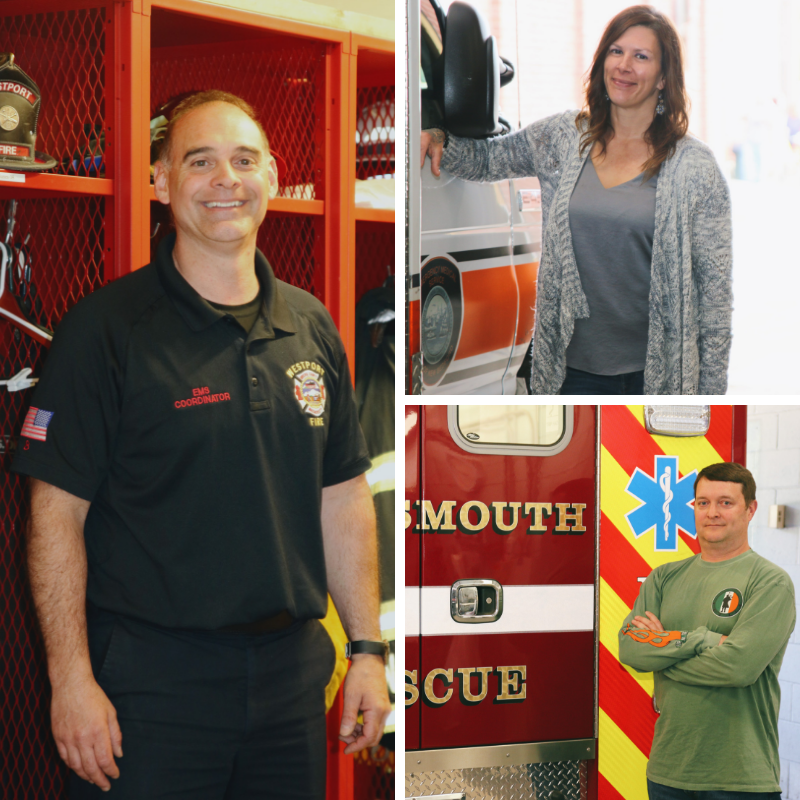
EMS Week has come to an end, but having met so many outstanding people over the course of it, we have to share some bonus content with you.
Clockwise from bottom right: Mark Reimels, Portsmouth EMS; Glenn Nunes, Westport EMS; and Janice Jope, New Bedford EMS.
Mark is a veteran of the war in Iraq who started volunteering as a first responder in Rhode Island at 16 years old (!) and is approaching 25 years as a paramedic, evolving along with his profession and still making a difference every day.
Glenn is indefatigable when it comes to fighting the threat of cardiac arrest to public health by educating the public and providing resources out of Westport and transporting patients to Charlton Memorial Hospital.
Janice is marking 20 years in the field with 15 as a paramedic. For the past five years, she has provided steady and inspiring leadership as a supervisor, but her work also goes well beyond the day-to-day. She leads donation drives for underserved communities in her beloved New Bedford and surrounding areas. “I feel that it’s my duty to give back,” Janice says. “Clothes, old work boots, gift cards … it’s never the same thing every year, but whatever we can do spontaneously around the holidays.”
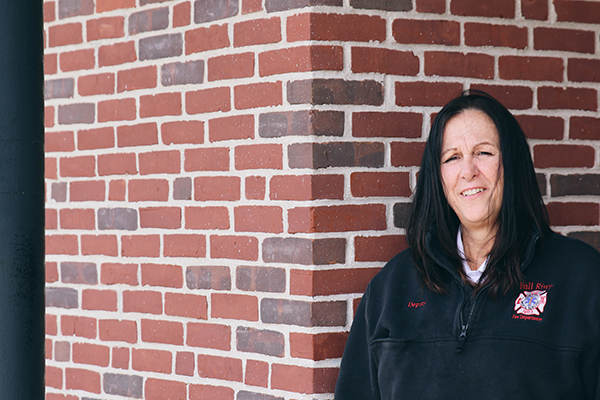
When we ask Beth Faunce what EMS Week (May 19-25) means to her, she doesn’t hesitate.
“Recognizing the people who respond to calls every day, who put everything on the line for other people to improve and save lives,” she says. “I think it’s important to remember that they’re all mothers and fathers, sons and daughters, brothers and sisters, and, in my instance, a grandmother. They work on Christmas, New Year’s, Mother’s Day. They leave their families behind and enter situations where they have no idea what to expect. That’s hard.”
And that’s just the job description’s bare minimum. This week’s theme is “Beyond the Call,” and Faunce, Deputy Director of FRFD EMS who joined the Fall River Fire Department in 1990, should probably be front and center on the official poster.
Her leadership of the Opioid Task Force during the past three years has helped stem the tide of overdose deaths in Fall River, and when it dawned on her how difficult it was to follow up with many patients because of homelessness, she marshaled volunteers to provide hot meals, drinks, snacks, socks, underwear, hygiene products, treatment, services, necessities, and even Hepatitis A vaccinations to these populations.
“We’ve developed a relationship with them, so now they really know us. It’s outreach. We take care of them the best we can, to keep them safe. We alert them to bad weather like snow and hurricane activity. Sometimes they just want a book to read, and that can go a long way,” Faunce says.
“We have a lot of support from the community. Donations of clothes, whatever people can do, which is good, because we’re not funded for this. Someone in the Charlton Memorial Hospital Emergency Department, a woman who comes to our Opioid Task Force meetings on occasion, put together packets that had hats and hand warmers and things like that for the winter to keep on rescues, in case we ran into someone who needed them, so that was really nice. Southcoast is always willing to band together to get us what we need. It’s amazing. I have people I’ve known there for 20 or 30 years, working on both a clinical level and as an administrator. Any time I’ve gone to them for anything, they’ve been more than supportive in helping me accomplish what I’m trying to accomplish.”
